
The war in Vietnam did not
get up to speed as rapidly as some might think…
combat wise things got off to a slow start. Up
until 1965 combat operations just sort of bumped
along. But around about the end of 1965 it all
began to change, as more and more units began
arriving in country, with their commanders
anxious to get it on.
To be more specific, America's
military involvement in Vietnam began with advisors sent to
assist Ngo Ding Diem’s rookie army in 1954. Between 1961 and
1964 their number grew from 900 to 23,000. Yet while the
number was significant, the involvement of these advisors
was minimal, being relegated to a narrowly defined
instructional and training role. It wasn’t until February
1965 that the U.S.' first independent combat operation was
mounted in what would become known as the Vietnam War, and
that involvement centered around a series of retaliatory
strikes after the Gulf of Tonkin incident.
Being what it was, no ground troops
were involved, as the strikes were carried out by the U.S.
Air Force and Navy. Strange as it was however, neither this
independent action on the part of the U.S. to escalate the
war, nor a decision made in February of 1965 to increase the number of
ground troops in-country by sending 3,500 Marines to Đà Nẵng, was shared with the South
Vietnamese government. Except for a trifling last minute
request to the South Vietnamese Premier Dr. Quat the morning
of the Marine's actual arrival on the beach—to issue a press statement supporting the
U.S.’ efforts—the South Vietnamese were kept in the dark
until it was too late for them to do anything about it.
Instead, miraculously, the Marine's amphibious assault craft
simply appeared on the horizon, world press just as
miraculously appeared on the beach, as did dozens of pretty
young Vietnamese girls dressed in áo dàis,
ready to drape the advancing Marines with leis. Does anyone
sense an ego at work here?.[1]
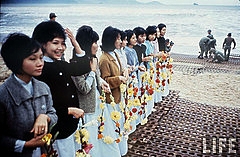 That
was the case for the 3,500 Marines
that landed at Đà Nẵng on March 8, 1965... and it was also
the case for the 20,000 support
personnel that were ordered to Vietnam on April 1, 1965, as
well as
the order issued on April 14 to deploy the entire 173rd Airborne
Brigade. For a war that was supposed to be about Uncle Sam
working hand in hand with the South Vietnamese government to gain control of the country,
upgrade the skills of the ARVN, help the ARVN oust the NVA and V.C.,
and set up a democratic system of government,
Westmoreland sure was keeping his "partner" in the dark
about his intentions.
That
was the case for the 3,500 Marines
that landed at Đà Nẵng on March 8, 1965... and it was also
the case for the 20,000 support
personnel that were ordered to Vietnam on April 1, 1965, as
well as
the order issued on April 14 to deploy the entire 173rd Airborne
Brigade. For a war that was supposed to be about Uncle Sam
working hand in hand with the South Vietnamese government to gain control of the country,
upgrade the skills of the ARVN, help the ARVN oust the NVA and V.C.,
and set up a democratic system of government,
Westmoreland sure was keeping his "partner" in the dark
about his intentions.
One wonders, if the government and
military of
South Vietnam... even in those early days... had a greater involvement in planning and
prosecuting the war, or at least understanding the logic
behind America's actions, might they not have been able to
go it alone when the time came? And if not... that is, if it
was not possible for the South Vietnamese ever to go it
alone... then what were we doing there in the first place?
Was the plan to stay forever? No? Then why wasn't the South
Vietnamese government and its military brought into the
equation day one and taught what they needed to know to run
their own country... including the knowledge that we
weren't going to stay forever and that they had better
get on about building both a democratic country and a
military that could defend it, instead of wasting their time
fighting internecine political wars for power while we
pursued Charlie in the boonies?
To this author it's amazing the
stupidity with which America fights its modern day wars to
free nations. Yes, it's o.k. to send our men into battle to
help free the people of another country... but if we are
going to do so then we should demand that the leaders of
that country step up to the task of creating both a
functioning government and a capable military. If the
leaders they pick don't prove up to the task, then we should
pluck them from power and tell the people of the country to
pick another one... and keep doing this until some local
George Washington steps forward and shows that he
understands his role is to be that country's George
Washington, not its Napolean.
Regardless, as the summer of 1966
approached things really began to “hot up.” By
August five new major combat units had arrived
in country, and with their arrival serious
combat operations got underway. Technically,
1966 represented the second year of serious
combat for the U.S. Army, but in reality it was
the first year when the Army had enough men and
materials to mount a vigorous, forceful,
coordinated effort. So in 1966 the war began in
earnest, and with it the Signal Corps was put to
the test.
Since most of the training
of the newly arrived Signal units had occurred
in Europe or the U.S., where methods of
communication between combat units had already
been codified into a science for some 20+ years,
it came as a surprise to those setting up the
systems in 'Nam that these same approaches to
the use and application of communication
technology were not operating as expected.
Instead, rather than finding that their deployed
gear worked swimmingly, what they found was that
things that had worked back home simply didn’t
work in Vietnam.
 One of the reasons, as
they quickly learned, was that while the terrain
back home and in Europe was benign and conducive
to the kind of communication architectures and
equipment the Army employed at that time,
Vietnam was proving to be different. More to the
point, what they found was that whether because
of the unique tactical scenario the enemy
presented in Vietnam, or the climatic and
geographic conditions that existed, getting
reliable communication up and running was not
only proving difficult but often times
impossible. Overall, getting communication links
in place to support tactical combat field
operations was turning out to be a real problem
for the Signal Corps in the early days of 1966.
One of the reasons, as
they quickly learned, was that while the terrain
back home and in Europe was benign and conducive
to the kind of communication architectures and
equipment the Army employed at that time,
Vietnam was proving to be different. More to the
point, what they found was that whether because
of the unique tactical scenario the enemy
presented in Vietnam, or the climatic and
geographic conditions that existed, getting
reliable communication up and running was not
only proving difficult but often times
impossible. Overall, getting communication links
in place to support tactical combat field
operations was turning out to be a real problem
for the Signal Corps in the early days of 1966.
To make matters worse,
while many units, like the 25th Infantry
Division, had trained for jungle operations in
climates similar to that of Vietnam, and had
learned something or two in the process, the
combat similarities they internalized didn’t
carry over to the Signal support personnel that
trained with them. That is, while for the
infantry boys combat simulation in a hot climate
proved to be similar to what they found in
Vietnam, this same training regimen was proving
to be of little value to the Signaleers arriving
in Vietnam. The reason was that what the combat
boys were up against was heat, while the Signal
guys were up against
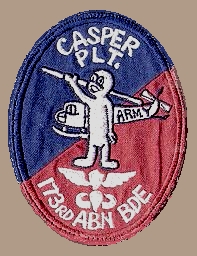 something entirely
different: a topographic environment far
different than either what they had trained in
or that which their equipment was designed for.
It’s one thing to learn to take a few salt
tablets and keep yourself hydrated, it’s another
to learn how to bounce a ridge line signal over
a bunch of hills and then aspirate it through a
jungle canopy until it hit the FM radios on the
other side.
something entirely
different: a topographic environment far
different than either what they had trained in
or that which their equipment was designed for.
It’s one thing to learn to take a few salt
tablets and keep yourself hydrated, it’s another
to learn how to bounce a ridge line signal over
a bunch of hills and then aspirate it through a
jungle canopy until it hit the FM radios on the
other side.
This
became evident when the first major combat
element to arrive in Vietnam, the 173rd Airborne
Brigade, discovered that it was having a devil
of a time communicating over extended distances
of any kind. In this case both local terrain
conditions and unit dispersal proved to be the
problem, for while the 173rd's troops were in
Vietnam their logistics base was in Okinawa. All
told, communication between the units HQ, their
logistics base in Okinawa, and their forward
bases in the field proved to be a bridge too far
for the signals equipment being relied on.
For
these guys, where normally voice communication
would be established around the use of the
standard single sideband radio equipment the
unit normally employed, in this new theater of
war this SOP approach was simply not working.
Paramount in this was the fact that the
distances involved were far beyond the designed
range for the assigned equipment, and even when
they weren’t the topographies involved defeated
the system’s ability to carry the signal over
the route needed. From day one then, the
Signaleers found they had to scramble to figure
out how to get voice communication up and
running.[2]
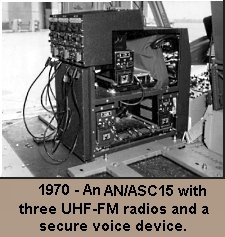 Part of the answer was
found in an expedient solution invented early in
1965, when some Signal guy somewhere mounted an
FM command and control console in a UH-1D
helicopter and took to the skies with it. This
improvised platform was then used as an airborne
relay to help get the message up and over the
obstacles involved, and the distances too, until
it reached the intended party. It proved to be
so effective that almost immediately the idea
was copied by other units throughout the
country.
Part of the answer was
found in an expedient solution invented early in
1965, when some Signal guy somewhere mounted an
FM command and control console in a UH-1D
helicopter and took to the skies with it. This
improvised platform was then used as an airborne
relay to help get the message up and over the
obstacles involved, and the distances too, until
it reached the intended party. It proved to be
so effective that almost immediately the idea
was copied by other units throughout the
country.
At the same time the
Signal Corps itself began designing a
communication system to fit in the Huey, so that
combat commanders like those just arriving could
take to the air and control their air assaults
in real time, rather than sit back in an office
somewhere in Nha Trang and try to second guess
the troops on the ground.
The first of these was
designated the AN/ASC6. It included a basic
console, two FM radios, one VHF radio, one UHF
radio, and one high frequency signal side band
radio. In essence, it tried to duplicate what
the earliest Signaleers had patched together as
an expedient to provide both airborne relay and
airborne command and control.
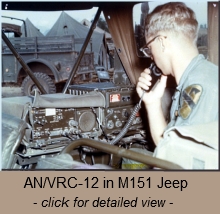 Historical Signal Corps documents claim that the AN/ASC6 was
brought to the field in 1965... if so, it must have been a
well kept secret as there are no contemporaneous accounts of
its use, while there are dozens of stories of kluged
airborne relay systems being built and launched by
eager, creative and driven E3 - E4 Signaleers. Instead, the
earliest accounts of it begin to pop up in early 1968, by
which time the AN/ASC10 was hitting the field, purportedly
to replace the mysterious and unaccounted for ANA/ASC6. As
for the difference between them, the AN/ASC10 provided an
internal intercom system for the command group onboard the
helicopter.
Historical Signal Corps documents claim that the AN/ASC6 was
brought to the field in 1965... if so, it must have been a
well kept secret as there are no contemporaneous accounts of
its use, while there are dozens of stories of kluged
airborne relay systems being built and launched by
eager, creative and driven E3 - E4 Signaleers. Instead, the
earliest accounts of it begin to pop up in early 1968, by
which time the AN/ASC10 was hitting the field, purportedly
to replace the mysterious and unaccounted for ANA/ASC6. As
for the difference between them, the AN/ASC10 provided an
internal intercom system for the command group onboard the
helicopter.
By 1968 every airborne
commander wanted his own command and control
chopper, outfitted with every radio he could get
his hands on. It was as though every LTC and above
had discovered the thrill of Ham radio. And of
course, the Signal Corps obliged, by introducing
the AN/ASC11, followed by the AN/ASC15. About
the time the war started to go flat again (1970–1971
and onward) hardly a commander of any stripe
didn't have his own little 'com center' following him around at all times.
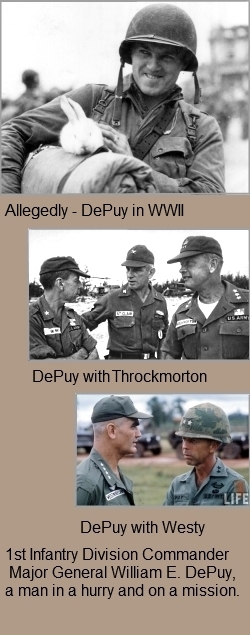 But back in 1966 those days were still a long way off, and
the Signal guys on the ground were struggling to get basic
communications up and running.
But back in 1966 those days were still a long way off, and
the Signal guys on the ground were struggling to get basic
communications up and running.
While the kludged airborne communication relay was a step in
the right direction, and something that clearly worked, the
concept still depended on bandaged together commo equipment
that was proving to have inherent limitations. For the most
part, the limitations found stemmed from reliance on older,
WWII series FM radio sets… equipment that simply didn’t have
the horsepower needed to deal with the environment Vietnam
presented. Worse, as more and more units arrived in Vietnam
they too ran into the same problems. Within a short while it
became painfully obvious that with or without the airborne
relay concept, a more permanent solution was badly needed,
and its use needed to be turned into a standard operating
procedure quickly.
For
the 173rd Airborne Brigade part of the solution came in late
1965 when the Signal Corps replaced the older series of
radio systems the unit was using with the AN/VRC-12 family,
along with AN/PRC-25 radios. For radiotelegraphy (i.e. high
frequency radio teletypewriter service between the
battalions and brigade) two AN/VSC1 sets were made available
to each battalion, while back at brigade headquarters a
shelter-mounted AN/GRC-46 was provided to interface with
them.
Hot on the heels of the 173rd other
units began to arrive in Vietnam. Among the other units that
arrived during this period was a brigade of the 101st
Airborne Division, a brigade of the 1st Infantry Division,
and another from the 25th Infantry Division. These units too
saw their commo systems upgraded—and none too soon, as major
combat operations began almost the instant the troops from
these units hit the ground. In fact, by late 1966 six major
combat operations involving the soldiers of these brigades
were either underway or had already occurred, with five of
the six happening in the II Corps central threat area.[3]
For
one of these campaigns the 1st Infantry Division (commanded
by Major General William E. DePuy) fielded an operation
called EL PASO II. It began on 2 June 1966, and depended for
its success on the solution to some weighty communication
problems… of both a logistical and operational nature.
From the get-go the 121st Signal Battalion had problems
deploying what was needed to support EL PASO II, as both the
men and the equipment it normally would have used were tied
up supporting the base camp complex at
Dĩ An.
Both men and material were dedicated to this large base
camp, and so it was necessary to find a way to extract the
121st from this duty so that it could focus its signal
duties on providing combat support for the 1st Infantry
Division, which was its normal organic role.
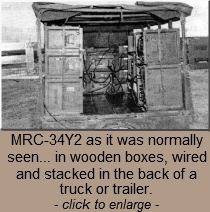 This was accomplished by reassigning the 595th Signal
Support Company to Dĩ An, attaching them to the 69th Signal
Battalion, and giving them responsibility for most of the
121st’s duties. An expedient, looking back now, one can see
that this quick fix was the beginning step in the never
ending game of “unit swap” that saw so many Signal Corps
units assigned, reassigned, and reassigned again throughout
the Vietnam War, until the TOE at the end of the war looked
nothing like it did at the beginning. Whether a mark of
typical American ingenuity or poor planning to begin with,
the flexibility the Signal Corps demonstrated as it moved
its units around the world to support operations in Vietnam,
as though they were pieces on a chess board, was a stroke of
genius. Come hell or high water, people and equipment were
going from where they were to where they were needed, the
TOE be damned.
This was accomplished by reassigning the 595th Signal
Support Company to Dĩ An, attaching them to the 69th Signal
Battalion, and giving them responsibility for most of the
121st’s duties. An expedient, looking back now, one can see
that this quick fix was the beginning step in the never
ending game of “unit swap” that saw so many Signal Corps
units assigned, reassigned, and reassigned again throughout
the Vietnam War, until the TOE at the end of the war looked
nothing like it did at the beginning. Whether a mark of
typical American ingenuity or poor planning to begin with,
the flexibility the Signal Corps demonstrated as it moved
its units around the world to support operations in Vietnam,
as though they were pieces on a chess board, was a stroke of
genius. Come hell or high water, people and equipment were
going from where they were to where they were needed, the
TOE be damned.
While the 595th helped free the equipment required for EL
PASO II, it didn't solve the problem of getting the
equipment to where it was needed, and making sure it could
be moved in real time as the troops moved. To solve this
problem the 121st copied what they had seen done by the 25th
Infantry Division. They modified the vans that carried the
VHF multi-channel AN/MRC-69 equipment by removing one stack
of AN/TRC-24 radio equipment and one stack of AN/TCC-7
carrier equipment (one-half the capability of the
AN/MRC-69).
 These
were then remounted in a 3/4-ton truck, or more usually
simply boxed in wooden crates that could be stacked together
on arrival at whatever forward base they were headed for,
wired back together, switched on and quickly operated while
the rest of the Signal squad built sand bag barriers around
this unattractive but all important pile of boxes. To make
the whole kludge look and sound like an authorized piece of
real Army equipment, the entire modified ensemble of commo
gear was given the name MRC-34Y2 and deployed. It proved
extremely successful in establishing VHF links in the field,
typically from a forward fire base back to a base camp. Best
of all, because the entire system weighed much less than the
AN/MRC-69 it was replacing, each individual wooden boxed
component could be hand carried by two men, slid inside the
belly of a UH-1, and transported along with the combat teams
as they moved from one forward base to another.
These
were then remounted in a 3/4-ton truck, or more usually
simply boxed in wooden crates that could be stacked together
on arrival at whatever forward base they were headed for,
wired back together, switched on and quickly operated while
the rest of the Signal squad built sand bag barriers around
this unattractive but all important pile of boxes. To make
the whole kludge look and sound like an authorized piece of
real Army equipment, the entire modified ensemble of commo
gear was given the name MRC-34Y2 and deployed. It proved
extremely successful in establishing VHF links in the field,
typically from a forward fire base back to a base camp. Best
of all, because the entire system weighed much less than the
AN/MRC-69 it was replacing, each individual wooden boxed
component could be hand carried by two men, slid inside the
belly of a UH-1, and transported along with the combat teams
as they moved from one forward base to another.
In the case of EL PASO II this proved invaluable as the
division and brigade command elements involved were spread
all over the tactical combat area, with ten distinct command
post locations operating at the same time. Many, being
expedient helicopter supported forward bases, were
inaccessible by any other means. Without the MRC-34Y2 being
Huey UH-1 helicopter-transportable, EL PASO II and the other
four combat operations that got underway in the summer of
1966 would have been in big trouble. Sure, bigger lifting
helicopters were available, but not in sufficient numbers to
support fluid combat operations where a forward operating
base might be changed every day of the week, and sometimes
twice on Sundays. Being able to rely on UH-1s made the job
of getting communication in place as the troops themselves
deployed doable. When the troops moved, their commo gear
followed them, in the same choppers that they rode in.
But that wasn’t the end of the problem. Unbeknownst to
everyone a new form of combat was in the process of being
invented, and this new form required that the Signal guys
that supported field operations had to invent new signal
solutions to cope with it.
Major
General DePuy turned out to be an aggressive combat leader.
Unlike General McClellan of Civil War fame, who couldn’t get
out of the way of his own shadow, or more precisely,
preferred not to, DePuy had no intention of letting grass
grow under his feet, or rice as the case may have been. His
plan was simple: move fast, hit hard. As a result he
initiated 1st Infantry Division tactics that rapidly
expanded the pace and scope of combat operations, more
quickly and intensely than any prior Vietnam Army commander
had. His troops moved as fast as the famous Generals Sherman
(again, of Civil War fame) and Patton (WWII), and possibly
faster, even without taking into account the fact that DePuy
rode on choppers while the best they had were horses and a
tank.
With DePuy it was not unusual to see a command post and a
few fire support bases appear one day, only to be moved the
next. DePuy’s approach correlated his troops physical
presence to the potential for action, putting his men in the
line of fire whenever he could, rather than waiting for the
line of fire to come to him. It may be an old infantry adage
that if you hear the sound of gunfire, head toward it, but
if it is, DePuy lived these words. He wanted to engage the
enemy and he expected his troops to move to do so whenever
the opportunity arose, even if that meant fighting while on
the move.
With this kind of an attitude what could the Signal boys do
but find new ways to not only keep up with him but prove
their mettle too by outpacing the ground pounders. This
caused them to have to come up with even more rapid
ways to deploy the communication assets at their disposal
and get them up and running quicker. In this case though the
problem wasn’t lack of equipment, it was the pace of
tactical combat change. In particular, the unique Vietnam
environment simply made communication at this pace anything
but reliable. The standard process deployment approach that
had been developed simply did not work. To fix the problem
the Signal boys turned to innovation again.
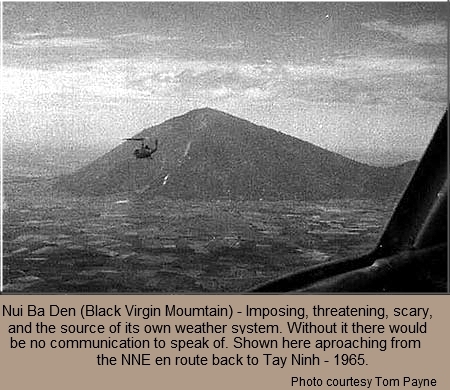 An
example of this can be seen at Nui Ba Den, one of the few
mountains of useful height in the 1st ID’s tactical area of
operation. It proved critical to maintaining a number of the
long multi-channel “shots” to the rapidly shifting forward
command post locations that filled the surrounding flat
land. But it wasn’t enough. After all, it was only one
mountain, where 20 were needed.
An
example of this can be seen at Nui Ba Den, one of the few
mountains of useful height in the 1st ID’s tactical area of
operation. It proved critical to maintaining a number of the
long multi-channel “shots” to the rapidly shifting forward
command post locations that filled the surrounding flat
land. But it wasn’t enough. After all, it was only one
mountain, where 20 were needed.
The answer of course was to erect signal towers. The only
problem was that back then the TOE for a Signal Battalion
didn’t include equipment for signal towers. Strangely, while
no such equipment existed or was authorized, signal towers
soon began to appear. Since few people knew that they
weren’t authorized or part of a Signal Battalion’s equipment
list, few people asked questions. For the most part
Captains, Majors, Colonels and the higher ranks that saw
them simply assumed that they were supposed to be where they
were, or they wouldn’t be there. No one asked how they got
there, who authorized them, or anything. And from the rank
of Lieutenant on down, no one told. When a tower was needed,
it just magically appeared. Another example of American
ingenuity at its best.
As to what they looked like, they were usually cobbled
together from the two standard issue systems that made up
the 45 foot AB-577 and the 65-foot AB-216. With a little
judicious use of guy wires these things could be erected up
to and over two hundred feet into the air.
How did the troops involved know this? Part of the answer
can be traced back to Army Signal OCS, at Fort Gordon, where
early 1966 Officer Candidates were shown how to erect
towers, guy them, and keep them up in the wind. Because of
this fortuitous training, when these same butter bars hit
the field in Vietnam and their EMs told them that the way to
solve the connection problem was to get the antennas up
higher than the surrounding terrain, they instantly thought
of the towers they had trained on back at OCS. The fact that
this solution involved equipment that was not authorized to
their units, or readily available, didn’t matter. What
mattered was getting the message through… and they knew that
could be done by simply putting an (unauthorized) tower
higher than anyone had before. Wet behind the ears as Second
Lieutenants they may have been, but intimidated they were
not. After all, they had themselves built these same towers
back on the fields of Signal OCS and so knew that the
equipment was strong, reliable, and not beyond their ability
to master.
 And so it happened, Enlisted ingenuity and the excitement of
Junior Officer command led to signal towers popping up all
over the place in the II Corps zone, authorized or not. Find
a field command post or forward fire base in Central Vietnam
and the chances are you would also find a couple hundred
feet of tower sticking up into the sky.
And so it happened, Enlisted ingenuity and the excitement of
Junior Officer command led to signal towers popping up all
over the place in the II Corps zone, authorized or not. Find
a field command post or forward fire base in Central Vietnam
and the chances are you would also find a couple hundred
feet of tower sticking up into the sky.
Whatever the cause, whatever the reason, it worked. These
off-the-cuff towers kept the VHF and UHF systems on air,
providing to every major combat unit the voice of command
they needed.[4]
As to what all of this accomplished, it set the tempo and
tenor for how tactical Signaleers would face the war ahead.
By combining rapidly constructed towers of the kind first
learned about back on the training fields of Signal OCS with
ground and light air-transportable equipment layouts, wooden
boxed pieces of signal equipment kluged from much larger
systems, air borne relay stations, and upgraded VHF and UHF
equipment, field signal platoons were able to install,
operate and maintain backbone field expedient multi-channel
trunking and switching systems able to meet the needs of any
tactical combat field unit… of any size… any complexity… at
any number of forward bases… in support of any combat team
with a fire in their belly to find and fix the enemy, and
jump to the occasion by moving itself at the trigger of a
trip wire from where it was to some other God forsaken
location in Vietnam… and then get up and do it all over
again the next morning.
Yet while all in all the system worked and worked well, it
wasn’t perfect. As the combat units settled into their
routines the pace quickened even more, bringing the rate of
combat engagement up several notches higher than that which
had been set when they first arrived in country.
The case of the 1st ID gives an example. For it the links
the commo guys set up between the main command post at Dĩ An
and the brigade main command post at Phuoc Vinh worked well,
but still only provided basic communication. So too for
communication between the brigade command post and the
division's forward command post at Lai Khe, and similarly
for division support command, which was tied into brigade
headquarters at Dĩ An. All in all, basic communication… with
a jump capability thrown in to tie together the division and
brigade tactical command posts whenever they were deployed.
But beyond that, the system simply could not keep up with
the evolving needs of the combateers, especially as their
commanders grew to spend more and more time in the air. In a
nut shell, the combat commander’s growing penchant to spend
as much time in the air as they could, applying and employing
helicopter borne command and control rather than pacing back
and forth in an office back in the rear, put a stress on
field communications that the Signal Corps had not seen in
all the wars before.[5]
How did the Signal Corps fix this problem? You’ll have to
read Part II to find out that answer. In Part II
we’ll take a look at the communication problem helicopter
borne command and control created, and how the Signal Corps
went about solving it. Join us there to continue the story of
the Signal Corps’ efforts in the 1965 – 1967 period, when
the war began in earnest.


Footnotes
[1]
Sources and cross check for comments about non-notification
of government of South Vietnam:
— Neil Sheehan, Hendrick Smith, E.W. Kenworthy, and Fox Butterfield, eds.,
The Pentagon Papers (New York: Bantam Books, 1971)
— William Bundy’s
unpublished manuscript, chapter 19, as read and commented on
by Bui Diem, member of the delegation to the 1954 Geneva conference,
Chief of Staff to the Premier of South Vietnam, 1965, et al.
— U. Alexia Johnson,
The Right Hand of Power (Englewood Cliffs, N.J.:
Prentice-Hall, 1984)
- To return to your place in
the text click here:
[2] For a well written, brief history of the 173rd in
Vietnam, see this Wikipedia article:

- To return to your place in the text
click here:

[3] EL PASO II, HAWTHORNE, PAUL
REVERE, SILVER BAYONET, MASHER/WHITE WING [Click here
for
map of combat operations]
- To return to your place in
the text click here:

[4] At Dĩ An base camp the tower stood at 120 feet. At
Christmas the Signaleers traded around until they had enough Christmas
lights to wrap the guy wires. To make sure the symbolism wasn’t missed, they
topped it with a huge star. One written archive of the time stated that when
“the Big Red One communicators gathered about the tower, the commanding
general of the division commended them for their outstanding work as
communicators and, at the conclusion of his remarks, officially lit the
‘tree’.” Little did he know that the tower was not part of the TOE, was
unauthorized and built from scrounged parts and materials. As the ceremony
proceeded, starting with a few 1st Lieutenants and on down through the
enlisted ranks, smiles and chuckles spread throughout the assembly as the
idea gained momentum that they were being commended for what was essentially
an unauthorized activity and something that flaunted SOP. For most of the
higher Officer ranks however, at least for those that noticed the levity and
jostling of the crowd, the question was bantered about as to what the troops
found so humorous that they could hardly contain themselves.
- To return to your place in the text click here:

[5] Dĩ An is a town in Binh Duong province in
southeastern Vietnam, about 20 km north of Saigon (now Ho Chi Minh City). It
is 1706 km by rail from Hanoi. As of the 2009 census the town had a
population of 73,859. The town covers 60 km².
- To return to your place in the text click here:

Additional Sources
Primary source material, data and statistics used in this
article taken from Vietnam Studies, Division Level Communication, 1962 -
1973, Lieutenant General Charles R. Myer.

Like this
synopsis of history? Let us know by
helping us with our scholarship fund efforts. A $30.00 donation
to our
Scholarship Fund
will help us get one step closer to helping another deserving High School
graduate attend college. Your donation is tax deductible and your
kindness will go father than you think in making
it possible for another young American to fulfill their dream of a college
education. Thank You!
This story originally published on our February 2013 Home Page.

